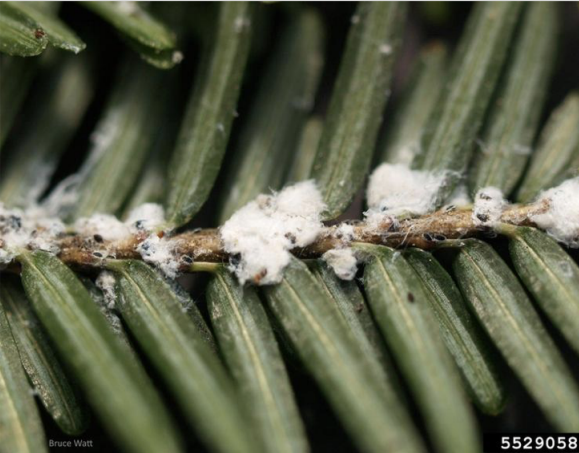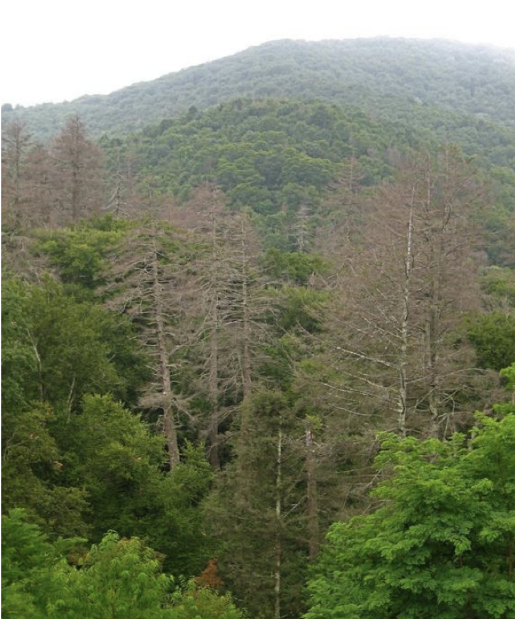Adelges tsugae (Annand)
Authors: Mark Abney, Benjamin Aigner, Entomologists, University of Georgia, 2022 Karla Addesso, Tennessee State University, and Elizabeth Benton, Jason Oliver, University of Georgia, 2019
Description
Immature stages: The eggs of the hemlock wooly adelgid, or HWA, are brownish-orange and darken as they mature. They are laid underneath a white, woolly secretion that resembles cotton. This coating can be observed at the base of infected tree needles. Youths hatch as flat reddish-brown crawlers.
Adult stages: Adelgids are soft-bodied, aphid-like insects. HWA adults are purplish-blackish in appearance, about 0.8 mm in length, and often covered by their woolly protective material.


Biology
Life cycle: HWA reproduce asexually and can have two generations per year: a short-lived progrediens generation and a longer-lived sistens generation. In early spring, the progrediens generation hatches and lives approximately 3 months with each nymph producing 25 – 125 eggs. The sistens generation hatches in late spring, remains dormant until late fall, lives approximately nine months, and produces 50-175 eggs per bug. The first-instar HWA nymphs, also called crawlers, are the only mobile phase. While crawlers do not move far on their own, they can be passively dispersed by wind, wildlife, and movement of infested nursery plants. Crawlers seek feeding sites at the base of hemlock needles. HWA inserts their strawlike mouthparts into the hemlock and begin feeding on carbohydraterich fluids near the xylem. As HWA grow they progress through four larval instars, and produce “wool,” which is a wax-like protective material. Hemlocks begin to decline once HWA nymphs deplete carbohydrate reserves.
Distribution: HWA is native to Japan, China, and the Pacific Northwest. The first population detected in the eastern United States was documented in Richmond, Virginia in 1951. Hemlock woolly adelgid has expanded its range in the eastern US from Virginia to other states: Connecticut, Delaware, District of Columbia, Georgia, Kentucky, Maine, Maryland, Massachusetts, New Hampshire, New Jersey, New York, North Carolina, Ohio, Pennsylvania, Rhode Island, South Carolina, Tennessee, Vermont, and West Virginia.
Damage
Asian hemlock species are resistant to feeding damage by HWA, but on eastern and Carolina hemlock, they can kill even the largest and healthiest trees. HWA feeding causes decreased growth, reduced ability to move water, bud death, less twig flexibility, and reduced mechanical strength of needles. Visible symptoms of an infestation are graying needles, dead branches, and canopy thinning. Hemlocks may die in as little as 2-4 years after initial infestation. Hemlocks in the southern US die more rapidly because winter temperatures are not cold enough to reduce HWA populations.
Management
Scouting for egg sacs and crawlers to treat early in an infestation can improve management success. HWA infestations are easily recognizable by their white, woolly egg sacs and crawlers on branch tips. Branches with graying foliage may indicate an infestation, and if present, crawlers can be found feeding at the base of needles in early spring.
- Localized infestations may be removed with pruning before treating the entire plant. Insecticides suitable for treatment of hemlock under nursery conditions include the active ingredients acetamiprid, imidacloprid, dinotefuran, bifenthrin, spirotetramat and horticultural oil. All of these products provide over 95% control for up to 46 days post application. Additionally, all of these products and application methods prevent second generation HWA establishment, with the exception of bifenthrin and horticultural oil. The longevity of many of these season long products permits growers to manage HWA with a single application in the spring when first generation HWA are most vulnerable. Dormant applications of horticultural oil are an inexpensive and effective way to prevent HWA establishment in production and should be considered as an annual prevention treatment for both HWA and mites.
- In nursery production, management options include foliar sprays and systemic drenches of insecticides. The best time for foliar treatments is early spring when first generation crawlers are most vulnerable.
- If a fast-acting treatment is required, foliar applications of spirotetramat or dinotefuran are options for growers wanting to treat and ship plants quickly.
- The most effective management programs will include the use of a systemic product for long residual control and a foliar application of a contact product prior to shipment. Rotation of products with different modes of action (different IRAC code numbers) and the use of horticultural oil are recommended to slow pesticide resistance development in HWA. Proper irrigation of hemlock trees will aid in uptake of systemic treatments and mitigate water stress caused by HWA infestations allowing for faster tree recovery.
All hemlock producers are required to follow state-level quarantine restrictions in order to limit movement of HWA into non-infested areas.
